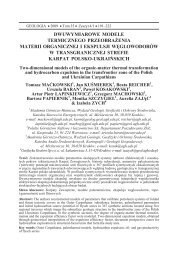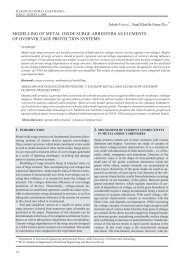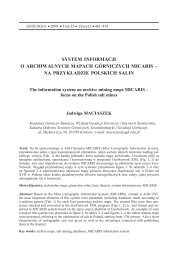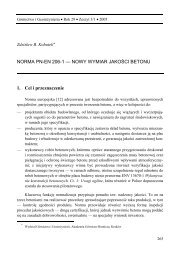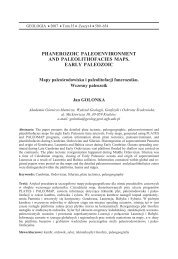You also want an ePaper? Increase the reach of your titles
YUMPU automatically turns print PDFs into web optimized ePapers that Google loves.
128 J. Wachowiak, M. Pawlikowski & P. Wilkosz<br />
Grey-orange salts representing the evaporites of cyclothem PZ-3. Various degrees<br />
of contamination with clay and sulphate minerals (mainly anhydrite) caused changes of<br />
salt colouring, from light to dark orange. Red, pink or orange halite colours were caused<br />
by the presence of microcrystalline or ferrous oxide and hydroxide inclusions. Salts of that<br />
type were identi ed in borehole Z-9, in three depth intervals of 860–865 m, 1,111–1,123 m,<br />
and 1,530–1,536 m (Fig. 3), although in case of the rst two intervals, the same folded layer<br />
was drilled through twice. In the bottom interval (1,530–1,536 m), such a repetition is also<br />
possible, but it is hard to identify owing to the completion of drilling works and lack of core<br />
data from lower layers. The occurrence of grey-orange salts was closely associated with the<br />
vicinity of zubers, anhydrites and potash-magnesium salts, with which the former created<br />
natural, strongly reduced evaporite sedimentation sequence of cyclothem PZ-3 (Fig. 3). Those<br />
salts were usually laminated with thin, light anhydrite laminas (1–2 mm) and dark trails of<br />
carbonate-clay substance. On the core surface, we could observe leached cracks and nests<br />
emptied by potash-magnesium salts. The structure of those salts was mixed and unevenly blastic.<br />
Pure pink salts were medium-blastic (2–8 mm blasts), or coarse-blastic close to anhydrite<br />
laminas and dark clay-carbonate trails. The diameters of some blasts reached 20 mm. Large<br />
halite blasts, visible on the core surface, were colourless, transparent, and they were clearly<br />
distinguished on the rock background. They often contained ingrowths of smaller red halite<br />
blasts, with the diameter of 1–2 mm, sometimes wrongly interpreted to be polyhalite. In the<br />
spaces between grains, we could see hydrocarbon trails and inclusions. The texture of the rock<br />
was layered in parallel, distinguished by light anhydrite laminas and sometimes, and in some<br />
areas with directional layout of elongated halite blasts, laid in parallel to layers. Insoluble<br />
part contents ranged from 2.5% to 3.8%. Exceptionally in some layers, the contents dropped<br />
to 0.4% (sample 9/1117). In grey-orange salts, ne grains of insoluble parts were clearly visible.<br />
The proportion of < 0.25 mm fractions was from 58.8% to 82.8% (Tab. 1, Fig. 10). The waterinsoluble<br />
residue was dominated by anhydrite, found in the form of polycrystalline aggregates<br />
in thicker fractions of > 0.6 mm, rarely in the form of mono-crystals, and in smaller fractions<br />
of < 0.6 mm, in the form of at, irregular plates, mostly circular or oval, and sometimes as<br />
poles and slats. The majority of crystals were shaped subhedrally. The upper and lower crystal<br />
surfaces were nished at, evenly, without characteristic barbs. They were slightly transparent.<br />
Side walls of crystals were transparent, with longitudinal strips. Quartz occurred in the<br />
authigenic form, with euhedrally shaped crystals of the size of 0.1–1.2 mm. Large crystals<br />
were grey-yellow, poorly transparent, often slightly etched on the column and pyramid walls.<br />
Smaller crystals were transparent, colourless, often with pink hue. Quartz contents usually<br />
did not exceed 1% in insoluble parts. Exceptionally, the proportion increased to 20% in dark<br />
orange salt from the depth of 1,117 m of borehole Z-9. Trace quantities of the ppm order displayed<br />
the presence of boracite, pyrite, magnezite, chlorite, and talk.<br />
The complex of the above presented such typical features of those salts as: proximity of<br />
zubers and potash-magnesium salts, orange-pinkish colour, domination of smaller fractions<br />
in insoluble parts, poor anhydrite recrystallization (lack of euhedral crystals), and rich proportion<br />
of accessory minerals, especially clay and borate ones, as characteristic for the rock<br />
salt cyclothem PZ-3.



